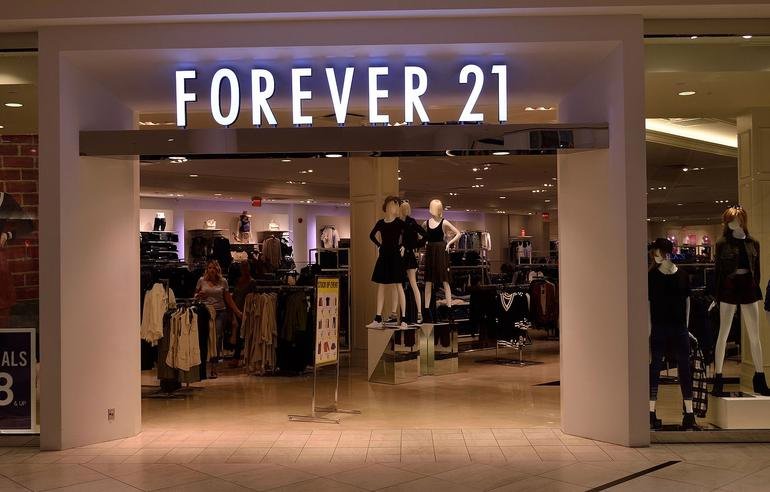Forever 21 reached its height of more than 800 stores and more than $4 billion in merchandise sales. Still, even with all its success, the business could not stay at the top. More competition, financial errors, and a hasty move into online shopping resulted in its demise.
Consumers loved the brand because it was:
- Super cheap.
- Super cute.
Now, Forever 21 is going bankrupt for the second time, closing U.S. stores, and firing hundreds of workers. But why did a brand that was so hot lose its heat so fast?
The Beginning of Forever 21

Forever 21 started in 1984 when a Korean couple, Do Won Chang and Jin Sook Chang, worked, saved $11,000, and opened a store in Los Angeles by the name Fashion 21.
Teen fashion was a successful business. The likes of established companies such as Aeropostale, Abercrombie & Fitch, and Gap controlled the market. Nevertheless, Forever 21 did something remarkable—it brought new styles to customers quicker than ever.
Fast fashion existed before. Topshop and Zara already enjoyed quick production of trendy pieces. What Forever 21 did better than others was to:
- Sell at even lower prices than the competition.
- Copy high-fashion styles at a fraction of the price.
- Bring new fashions quickly to market, resonating with youth consumers.
Forever 21 was the favorite among teenagers by 2011 when 12% of teen consumers identified it as their number-one apparel brand. By 2014, the firm achieved its peak sales level of $4 billion and grew strongly outside the United States.
The Cost of Aggressive Expansion
Forever 21’s immense popularity encouraged rapid global expansion. The company opened more than 200 international stores, at least 70 of which measured 35,000 square feet or more. It even operated a gargantuan 90,000-square-foot store in Times Square.
But this growth came with a high price:
- Huge stores needed enormous inventories to remain well-stocked.
- Operating expenses mushroomed, making it ever harder to make a profit.
- International sales lagged behind, resulting in enormous losses.
By 2019 and 2018, Forever 21’s Canadian, European, and Asian stores were averaging a loss of $10 million annually.
Meanwhile, malls in the U.S. were suffering. As more people shopped online, they went less to physical stores. Since Forever 21 depended so much on malls, its revenue kept dropping. More people visited traditional stores. Since Forever 21 relied heavily on malls, its sales continued to decline.
What led to Forever 21 Bankruptcy?

Forever 21’s greatest error was its reluctance to go along with online shopping.
By the time Forever 21 declared bankruptcy:
- Its e-commerce made up only 16% of its overall sales.
- Competitors had already gone digital strong.
As shopping behavior changed, hip fashion consumers flocked to online-first retailers such as Shein, ASOS, and Fashion Nova. Forever 21 never adjusted quickly and was still oriented toward physical stores.
Forever 21 was bleeding cash by 2019—$120 million a month since declaring bankruptcy.
Rescue Effort by Mall Owners
As Forever 21’s bankruptcy risked the shopping malls, three big players came forward to rescue it:
- Authentic Brands Group—a company that buys ailing fashion brands.
- Simon Property Group—a leading U.S. mall owner.
- Brookfield Property Partners—a large real estate investment company.
These firms sought to keep Forever 21 stores operating to avoid a retail domino effect. If Forever 21, a big-box retailer, vanished, malls would lose shoppers, and other businesses would be hurt.
To rescue Forever 21, these companies:
- Reduced rent charges, making lease contracts more negotiable.
- Indexed rental payments to sales results, giving Forever 21 fiscal breathing space.
Shein and the New Era of Fast Fashion
Despite this safety net, Forever 21 faced an even bigger challenge: Shein.
Shein transformed the fast-fashion business by:
- Employing AI-powered data to forecast trends in a timely manner.
- Producing clothing at record-breaking speeds through a vast network of Chinese factories.
- Selling items even cheaper than Forever 21.
For instance:
- A Forever 21 graphic T-shirt retails for $11.
- A comparable Shein T-shirt sells for $5.
With prices this low, customers flocked to Shein and Temu instead of traditional fast-fashion stores.
To compete with this, Forever 21 collaborated with Shein in 2023 so Shein could sell Forever 21 items on their website. Although this generated some revenue, it wasn’t enough to rescue the struggling brand.
Forever 21’s Final Struggle
The last remaining Forever 21 stores in the U.S. have initiated liquidation sales with discounted prices on merchandise as of 2024. However, this doesn’t indicate that the brand is gone.
Forever 21 continues to be owned by Authentic Brands, and its global stores are still open. The company is convinced that even if Forever 21 is not profitable in the long run, it still has a function—to bring traffic into malls and retain customers.
1. Change Quickly
Forever 21 was slow to adapt to e-commerce. Businesses should be fast in adopting new technology and trends.
2. Expansion Should Be Sustained
Growing too fast put too much pressure on Forever 21’s finances. Companies need to expand at a sustainable level.
3. Competition Never Stops
Forever 21 succeeded by providing cheap fashion, but Shein did it better and quicker. Companies need to stay ahead by innovating all the time.
4. Partnerships Help, But They’re Not Enough
The SHEIN partnership brought in revenue but couldn’t reverse years of bad choices. A change in long-term strategy was required.
Will Forever 21 Make a Comeback?
Forever 21 bankruptcy story is that of a brand that never evolved. It once revolutionized the fast-fashion space but then fell prey to its own antiquated tactics.
Would Forever 21 recover? Possibly. Authentic Brands still owns the company, and if it gets fully behind e-commerce and becomes as innovative as its rivals, it may be able to make a comeback.
One thing is certain—fast fashion is evolving, and only the most flexible brands will be left standing.
Increased competition from Shein and Temu, financial mistakes, and a slow e-commerce shift led to its downfall, forcing it to file for bankruptcy twice.
Overexpansion, reliance on physical stores, slow digital adoption, and declining mall traffic hurt its long-term sustainability.
While initially strong, its branding failed to evolve with digital trends, making it less appealing to younger, internet-savvy shoppers.
While low prices attracted shoppers, they also led to thin profit margins, making it difficult to sustain business during economic shifts.



